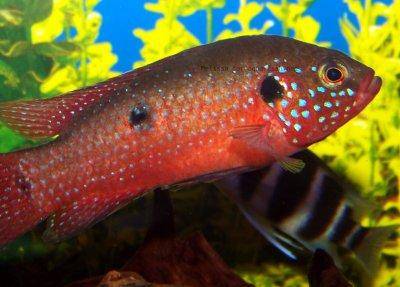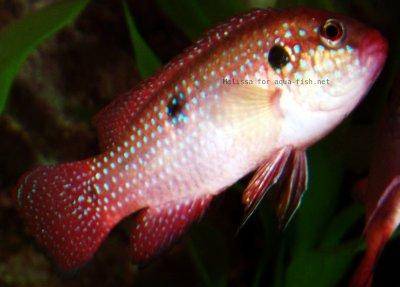The Jewel Cichlid - Proper care, Sexing, Breeding & Forum
Quick navigation - Answers
Brief Description
This article offers information about raising Jewel cichlids including pictures, forum for sharing experiences and asking questions and links to other interesting webpages devoted to these cichlids. We'd love to hear about your Jewel cichlids; use a form at the bottom of this page to tell us your story, please! Also visit these pages: Jewel cichlid - Hemichromis bimaculatus profile with forum and Banded jewel cichlid - Hemichromis elongatus profile.
Introduction
The Hemichromis genus is the scientific name for the commonly known jewel cichlid of the cichlidae family in the aquarium industry. This name broadly includes common species such as H. peynei, H. lifalili, and H. gutattus all with subtle differences. One species can be easily mistakable for the next to the novice aquarist. The most common of all the Jewel cichlid species is the Hemichromis bimaculatus which is characterized by two prominent black spots on each side of the body. There is a red variety and a blue variety of this species. Both colours possess turquoise, jewel-like spots that stand out brilliantly on the body and tail of well-kept specimens. This is a moderately priced fish in aquatic retail, selling for approximately $10 per fish.
Origin and conditions in the tank
A native species to Central and West Africa, these fish can be found swimming in middle to top water of muddy bottomed rivers and streams. The mature jewel will be 4 - 6 inches (~ 10 - 15 cm) in length and can be aggressive when pairing up and spawning. These carnivorous hunters are not to be trusted with any species that will fit in its mouth. They have a bad reputation of being overly aggressive however this is not always the truth. My Jewel is quite tame compared to the rest of his tankmates. The preferred temperature range is 74 - 80ºF (~ 23 - 27°C) with optimum water being soft with a 6.5-7.5pH. Jewels thrive in a well planted tank with hardy plants such as the Java fern and Anubias. These are plants with well secured roots that anchor them to wood or rocks allowing them to survive the digging behaviour of the Jewel cichlid. The jewel lives an average life span of 5 years but they can live longer depending upon how well they are cared for. They have the tendency to swim with their fins tucked in close to their body and the reason for this is yet to be determined. This fish requires no less than a 40 gallon (~ 151 litres, 33 Imperial gallons) tank, more when spawning in the presence of tankmates. The jewel can be compatible with a variety of other cichlids of a less aggressive nature such as peacocks and brichardis.
Sexing
Sexing is in the Hemichromis family is very hard. The subtle differences being females are rounder and slightly smaller than males. There is no easier or definite way to determine the sex of this fish without killing it.
Jewels form monogamous pairs as many cichlids tend to do. Once they are in a compatible pair it is easy to breed them. The problem is finding a pair that will not kill one another. These fish get overly aggressive, male towards female and vice versa, if they do not like the mate you have paired them with. When introducing a male to a female it is important to observe their interaction for a period of time to determine whether they are getting along well or if one needs to be removed. If an incompatible pair is not separated on time this can result in shredded fins and one or both fish may be wounded or killed. Once a pair finds that they are compatible, the male will be ready to spawn and his colours will become dramatically more vibrant. If the female is not yet ready to spawn you must remove her or the male will kill her.
Breeding the fish
Upon finding a suitable mate, a female will lay as much as 500 eggs on a surface that she has cleaned and prepared. She will lay her eggs through her ovipositor which is wider than the male’s. An ovipositor is a tube-shaped organ used for egg-laying and fertilization. The male, using his ovipositor, will fertilize the eggs that the female has neatly laid on a flat rock. Sometimes jewels like to spawn on the inside of rock caves or terra cotta flower pots, but mostly they like to spawn on the surface of a flat, smooth stone. The eggs hatch in about two days and the parents demonstrate highly developed brood care. The mother will take the newly hatched fry and hide them for a period of time until they absorb their yolk sacs and become free-swimming. This process can about three days and is common practice among many species in the cichlidae family. The father will protect the brood and form an imaginary perimeter through which he will allow no other fish to penetrate. The mother also helps to ward off any predators while remaining very close to her fry. Jewel parents will look after their young until they grow to about half and inch in length, after which, the parents send them out on their own to fend for themselves.
Different variations of Jewel cichlids are readily available in the aquarium industry without specified naming. To the untrained eye one variation is just the same as all the rest. There is very little information to be found about the different varieties of Jewel cichlids and many books confuse readers by using the generic name Hemichromis bimaculatus or Hemichromis lifalili. To the best of my knowledge, the commonly found jewels in retail aquatic stores are likely to be hybrids of different variations. We will never really be able to know for sure.
Sources
- Aquarium Fish by: Ulrich Schliewen
- Dorling Kindersley Handbooks: Aquarium Fish by: Dick Mills
- Encyclopedia of Aquarium and Pond Fish by: David Alderton
Other webpages devoted to the Jewel cichlid
Even though we've done our best to help our readers raise Jewel cichlids, you're welcome to visit other websites that contain valuable information about these species too. Before you do so, make sure that you've finished here, which means reading articles and sharing own fishkeeping experiences. The websites that are worth a visit are as follows; Jewel Cichlid Varieties @ SydneyCichlid.com, Jewel Cichlid - Hemichromis bimaculatus @ AquaHobby.Com, Hemichromis guttatus @ Cichlid-Forum.Com, Jewel Cichlid - Hemichromis bimaculatus @ FishLore.Com, FAQs on Jewel Cichlids @ WetWebMedia.Com, Jewel Cichlid - African Cichlids @ AboutFishOnline.Com, Fish Profile for Jewel Cichlid @ AquariumLife.Net. If any of the links doesn't work, contact us, please.
Questions/Answers
On March 23th 2011 we moved the following question and answer here due to merging aqua-fish.net/answers with related pages. You're welcome to post own questions, use a form that can be found at the bottom of this page, please.
-
What do I need to do now my Jewel Cichlid has laid eggs?
Answer: Jewel cichlids, in time will make good parents. They should protect the eggs and subsequent fry but keep them well fed. The fry can be fed on newly hatched brine shrimp when they are free swimming.




